String Quartet No. 2
-
Ships in 2 to 3 weeks
Details
Description
SKU: PR.11440505S
Composed by John Downey. Full score. With Standard notation. 53 pages. Duration 25 minutes. Theodore Presser Company #114-40505S. Published by Theodore Presser Company (PR.11440505S).UPC: 680160008391. 11 x 14 inches.
Although structurally it subdivides into five movements, the entire quartet emerges as one vast continuum. There are no formal breaks between movements. However, certain musical signposts can be discerned, associated with each of the movements' terminations and new beginnings. The opening movement, "The Nostalgia of Clanging Bell Sonorities", begins floating on recurrent Bbs whose soft rhythmic flow slowly puts into motion strong undercurrents suggestive of the latent power of water... After several suggestions of tolling bells, the movement gradually fades into hushed tones of veiled and very distant sonorities. It uses a unique effect, for the first time in a musical context, conveyed through the use of extra heavy practice mutes. The second movement, "The Spill of Water", disengages itself from the first through its distinct contrast in tempo. Water moves fast, and when it splashes, it tends to run wildly. In this case, it happens to be bubbly water that gushes forth bodly... smashing across rocky shorelines. So, too, the music attempts to conjure such moods. At the end of this movement, a cello cadenza emerges, introducing an introspective type of melodicism. The third movement, "The Poignancy of Memory", contains many silences as it tries to convey memory through fragmented remembrances much like often occur in our dream state. Progressing through several slowly building images, it gradually works itself into juxtaposition of musical images. Towards the movement's end, high harmonics are sounding in all four instruments while left hand pizzicato notes in the cello pluck the last remembrances of this central core. Almost imperceptibly, the viola assumes leadership as it dissolves into: The fourth movement, "The Fluidity of Motion", which has mostly the viola, but also the cello, articulating lyrical statements against sheets of sound conjured up by the two violins playing a flood of swirling figures, evokes a kind of static motion in space. Here , the virtually imperceptible manner in which this "hushed whisper" continues incessantly, can suggest the potential fluidity with which movement may inch forward... Later into the fourth movement, two fairly extended solos by the second and then the first violins, lead to a kind of spontaneous dialogue amont the four instrumentalists. Eventually, this musical conversation gets caught up in: The fifth movement's "The Rush of Time", which opens with a hushed flurry of speed, precipitates the Finale. It generates, at first slowly, but then very swiftly, whole shifts of rhythmic fields that initially seem to conflict with one another. Ultimately, this use of "psycho-rhythmics" contributes to an on-rush seem of motion and time. Rhythmic changes are, at times, abruptly precipitated with but little or no preparation creating a kind of inevitability in forward thrust, while the movement rushes forward with a feeling of gradual and continuous acceleration. It gathers density as more and more notes are piled progressively upon successive beats. The attempt is to spark tension and ignite excitement by means of frenetic confrontations of dissimilitudes. Ultimately - with the help of time - these polarities centrifically spin out their own destinies with their accompanying fall-out and own inevitable resolutions.

 Share
Share